Class A roofing materials: Top 7 Powerful Fire-Safe Choices 2025
Understanding Class A Fire Resistance for Your Home
Class A roofing materials are non-combustible products that provide the highest level of fire protection for your home. These materials undergo rigorous testing to ensure they can withstand severe fire exposure without igniting or spreading flames.
Here’s what you need to know about Class A roofing materials:
| Material Type | Examples | Stand-Alone Rating? | Key Benefits |
|---|---|---|---|
| Metal | Steel, copper | Yes (most types) | Lightweight, durable, quick-cooling |
| Concrete/Clay Tile | Flat or barrel tiles | Yes | Long-lasting, natural appearance |
| Fiberglass Asphalt | Architectural shingles | Yes | Cost-effective, widely available |
| Synthetic Slate/Shake | Polymer composites | Typically yes | Lightweight, impact-resistant |
| Aluminum | Metal panels | By assembly only | Corrosion-resistant, lightweight |
Class A rated materials are crucial in wildfire-prone areas and are often required by building codes. They can withstand severe fire exposure, with a flame spread index of 0 to 25 and minimal smoke development.
As one fire safety expert notes, “Here’s a recipe for disaster: a real cedar roof, drought conditions, and a fire-causing lightning strike.” Class A materials eliminate this risk by providing superior protection against embers, which can travel up to a mile during wildfires.
I’m Adam Kadziola from DML USA Metal Roofing, where we’ve been manufacturing high-quality Class A roofing materials since 2007, helping homeowners protect their investments with fire-resistant metal roofing solutions that combine safety with aesthetic appeal.
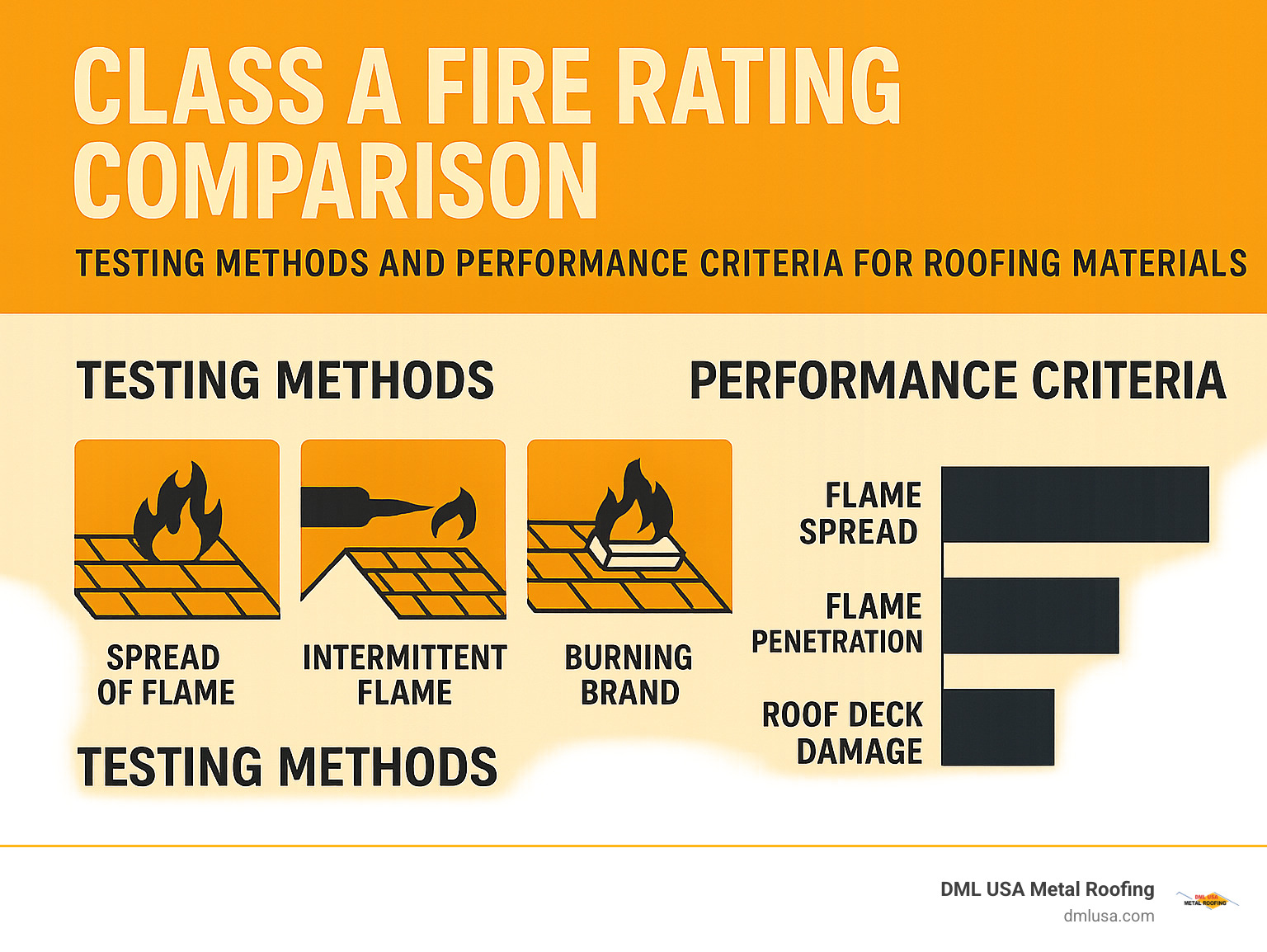
What Class A Roofing Materials Really Mean
When your home is your sanctuary, you want the best protection possible – especially when it comes to fire safety. That’s where Class A roofing materials come into the picture. These aren’t just premium products; they represent the highest level of fire resistance any roofing material can achieve.
Think of the fire-rating system as a safety report card, with Class A earning the top marks. This isn’t just marketing jargon – it’s a scientifically tested classification that could literally save your home during a fire emergency.
The rating scale breaks down into three main classifications, with a clear hierarchy:
Class A materials offer exceptional protection, standing strong against severe fire exposure. These are your A+ students in the fire safety classroom.
Class B materials provide good but moderate protection – reliable, but not top-tier.
Class C materials meet minimum acceptable safety standards – they pass, but just barely.
And then there are unrated materials (like untreated wood shakes) that simply can’t make the grade on any level of fire protection.
To earn that coveted Class A status, roofing materials must excel in specific performance areas: maintaining a flame spread index between 0-25, keeping smoke development between 0-450, and limiting heat release to 150-300 watts per square meter. These aren’t arbitrary numbers – they’re carefully calibrated measurements from rigorous testing protocols established by trusted organizations like ASTM E108, UL 790, and NFPA 256.
The importance of choosing Class A roofing materials becomes crystal clear when you consider wildfire statistics. The National Interagency Fire Center reported nearly 70,000 wildfires burning over 7.5 million acres in 2022 alone. In high-risk areas, having a Class A roof might be the difference between posting “We survived!” photos or sifting through ashes after a wildfire.
Stand-Alone vs By-Assembly Class A
Not all Class A roofing materials are created equal, and understanding the difference between stand-alone and by-assembly ratings could save you both headaches and heartaches down the road.
Stand-Alone Class A materials are the overachievers – they inherently meet Class A requirements without needing any help. These self-sufficient materials include concrete and clay tiles, most metal roofing (like steel and copper), and fiberglass asphalt composition shingles. They bring their fire resistance with them, no additional assembly required.
By-Assembly Class A materials, on the other hand, need a little help from their friends. These materials only achieve their Class A rating when installed with specific additional components. Aluminum roofing falls into this category, as do fire-retardant treated wood shakes and certain synthetic products.
For by-assembly systems, the underlayment isn’t just an afterthought – it’s a crucial safety component. Common elements include a 72-pound mineral-surfaced non-perforated cap sheet, Type X gypsum board underlayment (typically 5/8-inch thick), or specialized fire-resistant felt underlayment.
As one seasoned roofing expert puts it: “When using by-assembly systems, you must include the tested underlayment exactly as specified. Any deviation could compromise the fire rating.” It’s a bit like baking – change the ingredients, and you change the outcome.
This distinction matters tremendously when you’re shopping for roofing materials. Don’t just ask if a product has a Class A rating – ask specifically whether it has a stand-alone rating or requires a specific assembly to achieve it. The answer could affect both your installation process and your long-term peace of mind when it comes to protecting your home from fire.
How Roofs Earn a Class A Rating: Testing & Certification
Getting that coveted Class A fire rating isn’t just a matter of saying your roof is fire-resistant—it’s earned through a series of tough, standardized tests that simulate real wildfire conditions. Think of these tests as the roofing equivalent of a firefighter’s training program—intense, demanding, and absolutely necessary.
The Three Primary Fire Tests
1. Intermittent Flame Test
Imagine your roof facing a relentless flame that switches on and off for fifteen two-minute rounds—like a boxer throwing punches with short breaks in between. To pass this test, your roofing material needs to stand its ground. It can’t allow flames to penetrate through to the deck beneath, can’t produce any flying burning pieces (we call these “brands”), and must stay firmly in place without shifting and exposing the vulnerable deck below.
2. Spread-of-Flame Test
This test is even more demanding. Your roofing material faces continuous flames for a full 10 minutes while being blasted with 12-mph winds. For Class A roofing materials, the flames must not spread more than 6 feet across the surface—anything more and you’ve failed the test. This mimics how a real fire might try to travel across your roof during a wildfire event.
3. Burning Brand Test
This is where things get really serious. Testers place a burning wooden “brand” (essentially a standardized piece of burning wood) directly on the roofing material. For Class A certification, your roof needs to withstand a substantial 12″×12″ burning brand without letting flames penetrate through, without creating flying firebrands of its own, and without continuing to flame significantly after the brand burns out. This test simulates what happens when burning embers from a nearby fire land on your roof—a common way homes ignite during wildfires.
Some materials also undergo an additional Flying Brand Test to ensure the roofing material itself doesn’t break apart and create new fire hazards when burning.
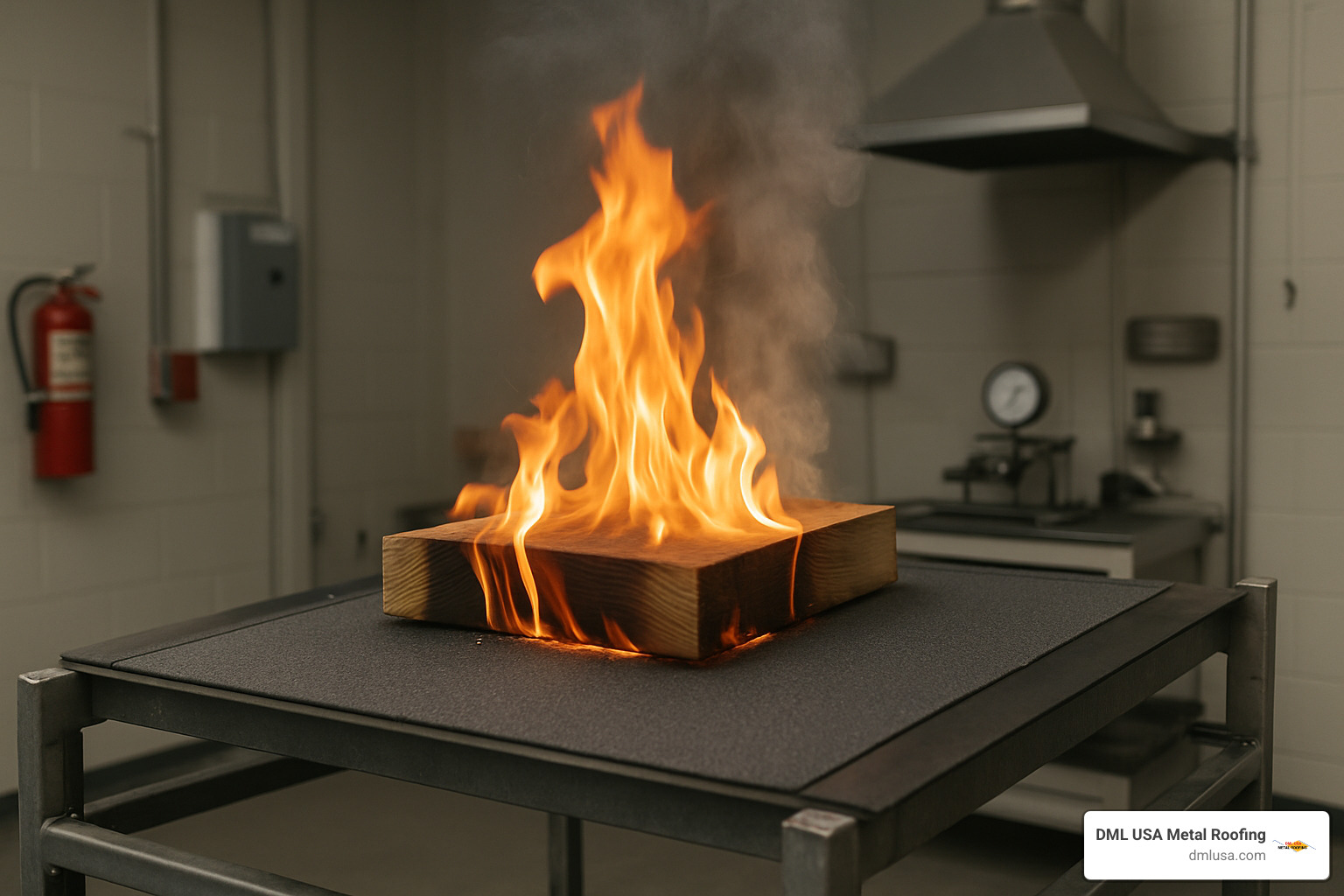
The Role of Deck Slope
The steepness of your roof actually makes a big difference in these tests. Standard testing typically uses a 5:12 pitch (5 inches of rise per horizontal foot), but steeper slopes create more challenging conditions. Why? Because fire naturally travels upward, and a steeper slope gives flames a more direct path to climb.
According to scientific research on wildfire roof ignition from the University of California, the slope of your roof significantly influences how quickly flames can spread across roofing materials. That’s why you’ll find some roofing products have specific limitations on the maximum slope where their Class A rating remains valid.
When comparing fire ratings, the differences between classes become quite clear:
| Rating | Flame Spread | Burning Brand Size | Penetration Resistance | Typical Applications |
|---|---|---|---|---|
| Class A | ≤ 6 feet | 12″ × 12″ | No penetration allowed | High fire risk areas |
| Class B | ≤ 8 feet | 6″ × 6″ | No penetration allowed | Moderate risk areas |
| Class C | ≤ 13 feet | 1.5″ × 1.5″ | No penetration allowed | Low risk areas |
As you can see, Class A roofing materials must withstand burning brands that are four times larger than Class B materials and significantly limit flame spread. That’s the difference between a roof that might save your home during a wildfire and one that might not.
These rigorous tests, standardized through protocols like ASTM E108 testing, ensure that when you invest in a Class A roof, you’re getting protection that has been thoroughly vetted against realistic fire scenarios—not just marketing promises.
Fiberglass Asphalt Composition Shingles
Fiberglass asphalt composition shingles have become the darlings of American roofing – they’re practically everywhere you look in residential neighborhoods across the country. And for good reason! These ubiquitous roofing materials earn a stand-alone Class A roofing materials rating while keeping costs manageable for the average homeowner.
Composition and Fire Resistance
What’s the secret behind their impressive fire resistance? It’s all in their thoughtful construction:
The magic starts with a sturdy fiberglass mat core – think of it as the backbone of the shingle. This non-combustible layer provides structural integrity while resisting flames. Then comes a waterproof asphalt coating that seals everything tight. The finishing touch? A sprinkling of ceramic-coated mineral granules across the surface that not only shields against harsh UV rays but creates a remarkable barrier against fire.
“The beauty of these shingles is their simplicity,” says one roofing veteran of 25 years. “Mother Nature throws sun, rain, snow, and even fire at them, but that combination of fiberglass and mineral granules stands strong year after year.”
Installation Considerations for Maximum Fire Protection
While these shingles come with built-in fire resistance, how you install them can take that protection to the next level.
Closed valleys make a significant difference. When two roof planes meet, interweaving shingles from both sides creates a seamless barrier that’s far superior to open metal valleys where leaves and twigs love to gather (and potentially ignite).
Quality underlayment adds another layer of defense. Though technically not required for the Class A rating, it’s like wearing both a belt and suspenders – extra protection never hurts!
Proper edge treatment deserves special attention too. Roof edges can be vulnerable entry points for windblown embers, so careful installation here pays fire-safety dividends.
Cost-Effectiveness and Longevity
Perhaps the most compelling aspect of fiberglass asphalt composition shingles is their remarkable balance of fire protection and affordability. Most homeowners find them comfortably within budget, yet they don’t compromise on safety.
With proper installation and basic maintenance, premium architectural versions can faithfully guard your home for 25-30 years while maintaining their Class A roofing materials rating throughout their lifespan. Their widespread availability also means finding qualified installers is rarely a challenge.
For homeowners seeking that sweet spot between robust fire protection and reasonable cost, these shingles continue to be a sensible choice. They may not have the century-long lifespan of some premium materials, but their combination of affordability, availability, and proven fire resistance keeps them at the top of many homeowners’ lists.
Non-Combustible Metal Roofing Panels
When it comes to protecting your home from fire, metal roofing truly shines as one of the most effective Class A roofing materials available today. There’s something deeply reassuring about knowing your roof won’t catch fire when exposed to flying embers during a wildfire.
Inherent Fire Resistance Properties
Metal roofing panels bring natural fire resistance to the table in ways other materials simply can’t match:
They remain steadfastly non-combustible when faced with flying embers – which is crucial since embers can travel up to a mile ahead of a wildfire front. Once the heat source is removed, metal roofs cool down quickly rather than continuing to smolder. And perhaps most importantly, they don’t add fuel to an existing fire.
Steel panels particularly excel in this department, offering stand-alone Class A fire ratings without needing any additional components underneath. This isn’t just marketing talk – the National Research Council has confirmed that metal roofs can withstand severe fire exposure without igniting or allowing flames to penetrate to your home’s structure.
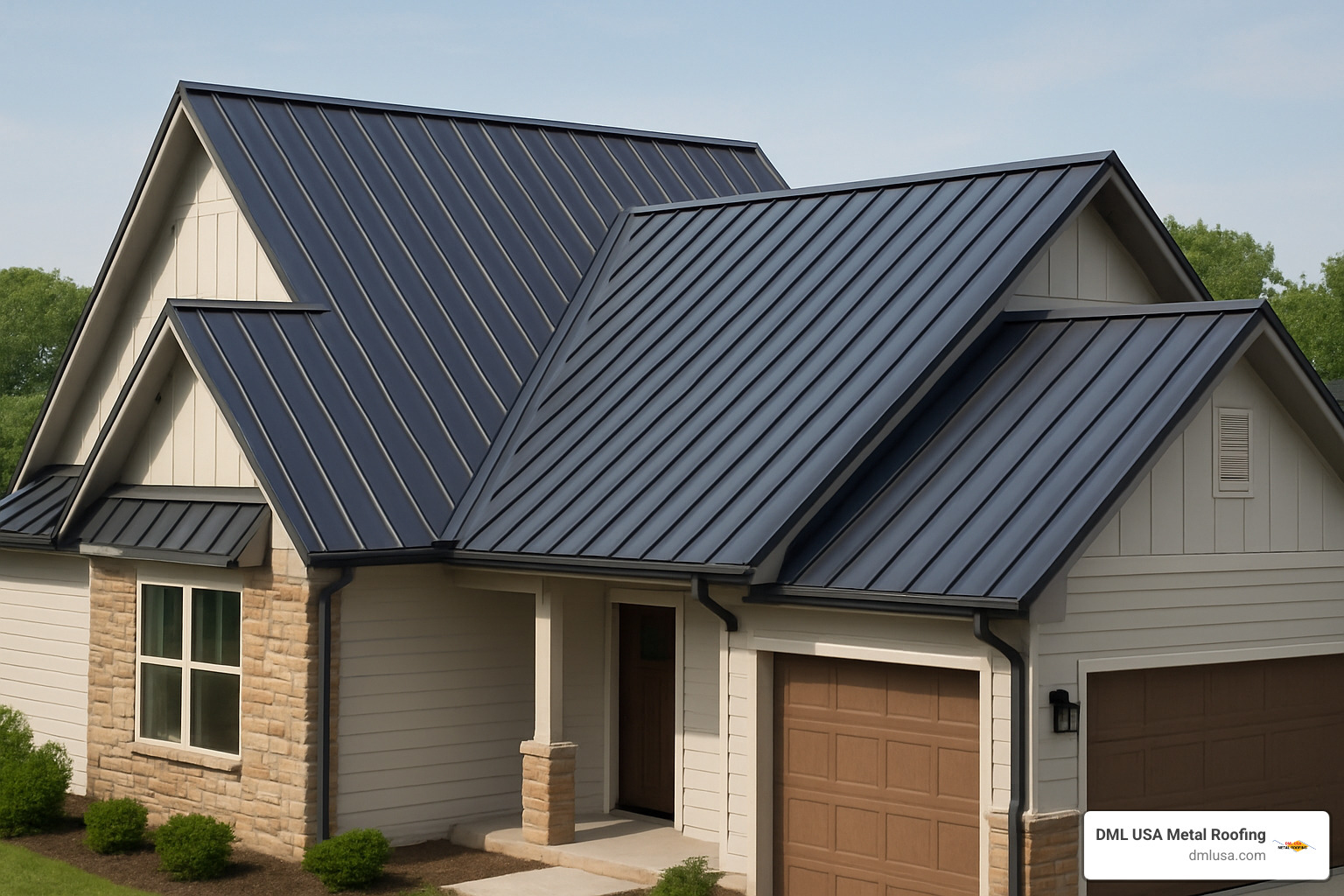
Types of Metal Roofing Systems
You have several excellent options when considering metal roofing for fire protection:
Standing Seam Systems create a sleek, contemporary look with their raised seams where panels join together. Beyond aesthetics, these continuous panels eliminate exposed fasteners and reduce potential entry points for those dangerous flying embers. Many homeowners love the clean lines and modern appearance.
Interlocking Metal Shingles offer the best of both worlds – traditional roofing appearance with modern fire protection. These systems feature panels that lock together to create a secure barrier against the elements. The four-way interlock systems secured with aluminum fastening clips provide superior seaming and exceptional fire protection.
Metal Shake and Tile Profiles are perfect for homeowners who love the classic look of wood shakes or clay tiles but need serious fire protection. These systems mimic traditional materials while providing Class A fire safety – no more choosing between aesthetics and protection.
The Aluminum Consideration
While steel panels typically achieve stand-alone Class A ratings, aluminum roofing often needs some help to reach the same fire-resistance level. This usually involves installing a mineral-surfaced underlayment, using specific attachment methods, and paying special attention to edge treatments.
As one roofing specialist explained to me, “Aluminum is definitely non-combustible, but because it has a lower melting point than steel, it often needs those additional protective materials underneath to achieve a full Class A rating.”
Insurance and Long-Term Benefits
The benefits of metal roofing extend far beyond fire protection. Many homeowners are pleasantly surprised to find insurance companies offer premium discounts for homes with Class A metal roofs – a nice acknowledgment of their superior fire resistance.
The longevity is remarkable too. Quality metal roofing systems often last 50+ years with minimal maintenance, making them a truly long-term investment in your home. They reflect solar radiation to keep your home cooler in summer, potentially reducing your energy bills. And when strong winds blow, metal roofing systems typically stand strong, withstanding winds of 110-150 mph.
For more information about why metal roofing makes sense for both safety and long-term value, check out our detailed guide on Why Choose Metal Roofing.
Concrete & Clay Tiles
Concrete and clay tiles have stood the test of time as some of the most dependable Class A roofing materials around. There’s something reassuring about materials that have protected homes for centuries, especially when it comes to fire safety.
Natural Fire Resistance
Both concrete and clay tiles achieve their stand-alone Class A fire ratings honestly—no additional components needed. Their exceptional fire resistance comes naturally from:
Their composition is inherently non-combustible (they’re literally made from earth and stone), they possess impressive thermal mass that absorbs and dissipates heat effectively, and they simply cannot generate flying embers when exposed to flames.
“In regions where wildfires are a seasonal threat, concrete and clay tiles offer peace of mind that few other materials can match,” notes a veteran firefighter from California. “They’ll stand up to direct flames and those pesky airborne embers that can travel surprisingly far on the wind.”
Styles and Configurations
Walk through any neighborhood with tile roofs, and you’ll notice several distinctive profiles—all providing that crucial Class A protection:
Flat Tiles create clean, contemporary lines while their tight installation pattern minimizes gaps where embers might find their way in. They’re particularly popular in modern architectural styles.
Barrel/Mission Tiles with their distinctive curved profile instantly evoke Mediterranean and Spanish-style homes. These timeless beauties offer excellent water-shedding capabilities alongside their fire resistance.
S-Tiles blend elements of both flat and barrel designs, creating a unique profile that many homeowners find visually appealing while maintaining excellent fire protection.
The Critical Importance of “Bird-Stopping”
Here’s where installation details really matter. While the tiles themselves won’t burn, proper installation is crucial for maximum fire protection. The term “bird-stopping” might sound quaint, but it addresses a serious vulnerability specific to tile roofs: the gaps between tiles and the roof deck, particularly at eaves and ridges.
Bird-stopping involves filling these gaps with mortar or specialized closure materials to prevent ember intrusion. Without proper bird-stopping, even the most fire-resistant tiles can be compromised as embers slip beneath them and ignite underlayment or structural members.
As one fire safety expert bluntly puts it: “Skip the bird-stopping, and you might as well install a chimney for embers to enter your attic.”
Weight Considerations
The elephant on the roof? Weight. At 900-1200 pounds per square (100 square feet), concrete and clay tiles tip the scales significantly heavier than alternatives like metal (50-150 pounds) or asphalt shingles (250-400 pounds).
This substantial weight requires adequate structural support, sometimes professional engineering (especially for retrofits), and special considerations in seismic zones where earthquake forces can amplify the impact of heavy roofing.
Interestingly, this weight presents a double-edged sword during severe fires. While the tiles themselves won’t burn, very heavy roofs may prevent firefighters from conducting interior operations due to collapse hazards if structural members are compromised.
Despite these considerations, the longevity of concrete and clay is remarkable—often lasting 50+ years while maintaining their fire-resistant properties. For homeowners who can accommodate the structural requirements, few Class A roofing materials offer such a compelling combination of fire safety, durability, and timeless aesthetics.
Synthetic Slate & Shake (Polymer, Rubber, Composite)
Modern synthetic roofing materials have transformed the Class A roofing materials landscape, giving homeowners the best of both worlds—the charming look of traditional materials with significantly better fire protection and durability.
The Evolution of Synthetic Roofing
Remember those beautiful but highly flammable cedar shake roofs? Synthetic alternatives were born from the desire to capture their aesthetic appeal without the fire hazard. Today’s synthetic options are crafted from innovative materials like engineered polymers, recycled rubber, and composite blends that often include recycled content.
Unlike traditional wood shakes, which can act like kindling during a fire, synthetic shakes are purposefully designed with fire resistance in mind. Many achieve stand-alone Class A ratings right out of the box, though some require specific underlayment assemblies to reach that gold standard of protection.
Fire Performance Advantages
What makes these materials so effective against fire? It’s all in the engineering. Synthetic roofing excels in fire testing because they’re built from the ground up to resist flames. Many contain fire-retardant additives throughout the material—not just as a surface treatment that can wear off over time.
When exposed to intense heat or flames, these materials hold their shape and position rather than curling, warping, or generating dangerous burning embers. As one manufacturer put it: “Synthetic roofing materials can convert a potentially fatal wildfire spark into a ‘non-event’.” That’s the kind of peace of mind that helps homeowners sleep better at night.
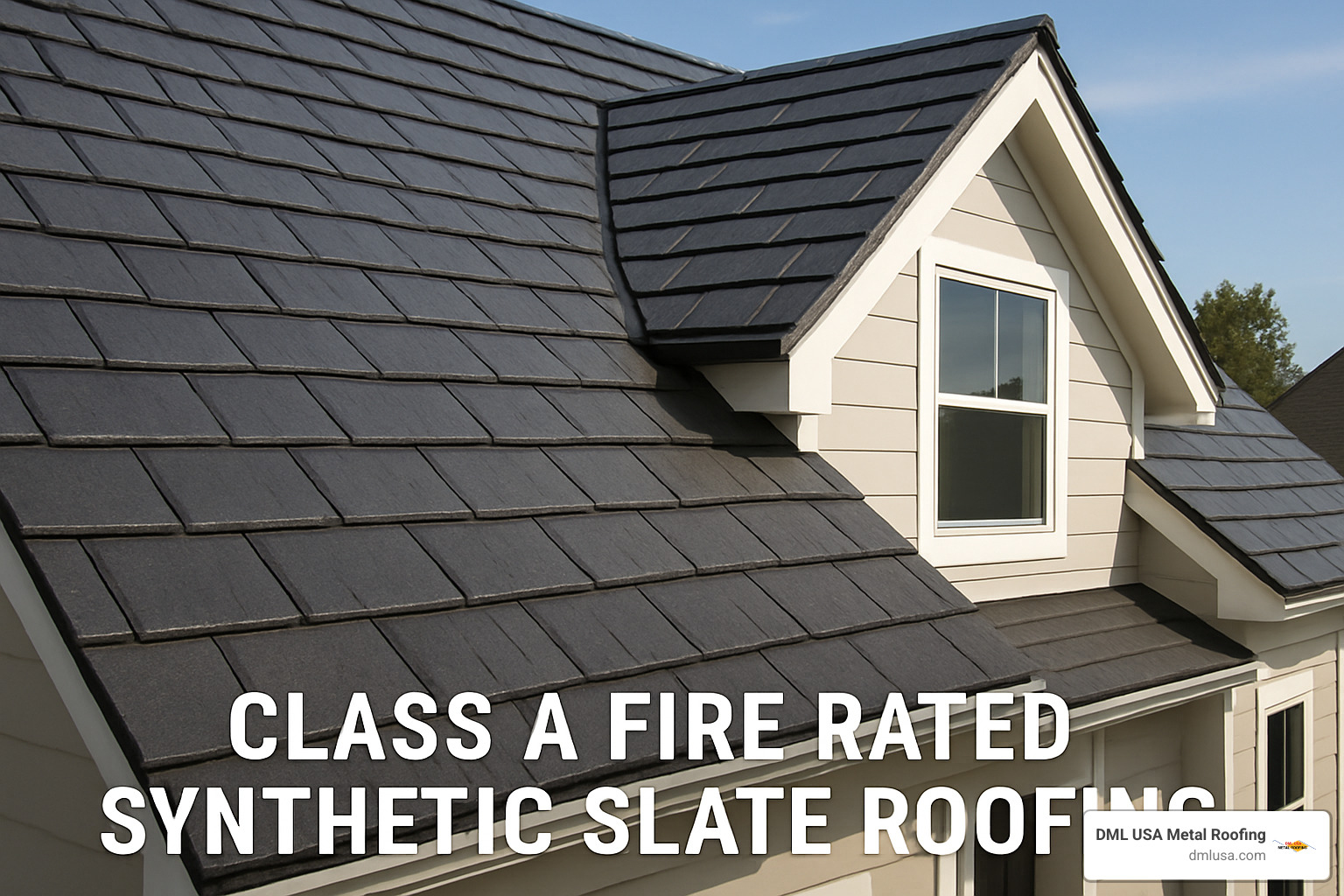
Additional Performance Benefits
The fire protection alone would make synthetic slate and shake products worth considering, but they bring other impressive benefits to the table as well.
When it comes to impact resistance, many synthetic roofing products achieve UL 2218 Class 4 ratings—the highest possible designation. This makes them particularly valuable in regions where both hail and wildfires are concerns. Your roof can stand up to golf ball-sized hail one season and flying embers the next.
Their lightweight construction is another significant advantage. Natural slate can weigh a backbreaking 800-1,500 pounds per square (100 square feet), and concrete tiles aren’t much lighter at 900-1,200 pounds. Synthetic alternatives typically weigh just 250-300 pounds per square—comparable to standard asphalt shingles and much gentler on your home’s structure.
The color stability of synthetic materials is remarkable too. Thanks to advanced UV inhibitors and fade-resistant technology, these products maintain their appearance decade after decade. As one roofing expert noted with a touch of humor: “Synthetic roofing materials use fade-resistant color technology that natural materials simply can’t match—unless you consider ‘weathered and faded’ to be your desired long-term look.”
Many homeowners are also drawn to the environmental benefits of synthetic roofing. Many products contain recycled materials and are themselves recyclable when they eventually reach the end of their impressively long service lives.
Installation Considerations
Even the most fire-resistant material needs proper installation to perform as intended. To maintain their Class A roofing materials rating, synthetic products must be installed according to manufacturer specifications. This typically includes using the recommended fasteners, following the prescribed overlap patterns, installing proper underlayment, and paying special attention to vulnerable areas like valleys and roof penetrations.
When properly installed, synthetic slate and shake products deliver excellent fire protection while offering the beautiful appearance of natural materials—without their inherent vulnerability to flames. For homeowners in wildfire-prone areas who don’t want to compromise on aesthetics, these innovative materials represent an ideal solution that’s truly the best of both worlds.
Class A Roof Assemblies with Specialty Boards & Cap Sheets
Some roofing materials achieve their Class A fire rating not as stand-alone products but through carefully engineered assemblies. These systems combine multiple components to create a fire-resistant barrier that meets or exceeds Class A requirements.
The Role of Specialty Roof Boards
Gypsum-based roof boards play a crucial role in many Class A assemblies. Products like DEXcell Glass Mat Roof Board serve as effective thermal barriers in both surface-burning and full assembly fire tests.
These boards offer several fire-protection benefits:
- They contain chemically bound water that releases as steam during a fire, slowing heat transfer
- Their non-combustible core prevents flame spread
- They maintain structural integrity longer than many alternative materials
Research shows that gypsum-based roof boards enable unlimited slope on commercial roofs without compromising UL Class A fire performance. This is significant because sloped roofs typically burn faster than flat roofs, yet these specialty boards maintain their protection regardless of pitch.
Mineral-Surfaced Cap Sheets
Another key component in many Class A assemblies is the mineral-surfaced cap sheet. These sheets typically feature:
- A fiberglass or polyester reinforcement mat
- Modified bitumen (SBS or APP) for flexibility and durability
- Ceramic-coated mineral granules on the surface for UV and fire protection
Products like Flintlastic® GTA exemplify this approach. As the manufacturer notes: “A properly installed, high-quality torch system creates a multi-layered barrier that will protect a building for decades to come.”
The mineral granules serve a dual purpose: they protect the underlying asphalt from UV degradation while providing a non-combustible surface layer that resists flame spread.
Creating a Class A Assembly
A typical Class A roof assembly might include:
- Structural deck (wood, steel, or concrete)
- Base layer (often a 72-lb felt or gypsum board)
- Intermediate layers (additional felts or modified bitumen sheets)
- Cap sheet (mineral-surfaced for maximum fire protection)
The specific components and installation methods must follow tested and certified assemblies. As one expert explains: “When using by-assembly systems, include the tested underlayment exactly as specified. Any deviation could compromise the fire rating.”
Retrofit Applications
Class A assemblies offer excellent options for retrofitting existing roofs to improve fire resistance. Common approaches include:
- Installing fire-rated gypsum board over existing decking
- Applying a mineral-surfaced cap sheet over properly prepared existing roofing
- Creating a complete assembly over an existing roof without tear-off
These retrofit solutions can transform an unrated or Class C roof into a Class A system, significantly improving fire protection without the cost and disruption of complete replacement.
Benefits of Choosing Class A Roofing
When you invest in Class A roofing materials, you’re getting so much more than just a roof over your head. The benefits extend far beyond basic fire protection, touching everything from your family’s safety to your bank account.
Improved Life Safety
Nothing matters more than keeping your loved ones safe. A Class A roof gives you precious extra minutes during a fire emergency – time that could literally save lives.
During wildfire events, your roof is like a giant catcher’s mitt for falling embers. A Class A roof stands strong against these embers, preventing them from igniting your home. As wildfire seasons grow longer and more intense across the country, this protection becomes increasingly valuable.
One firefighter I spoke with put it perfectly: “In a wildfire, your roof is your first line of defense. A Class A roof can be the difference between minor repairs and total loss.”
Property Value Protection
Homes sporting Class A roofing materials tend to command higher resale values, and for good reason. Today’s buyers are more informed than ever about building materials and safety features.
Beyond safety, many Class A materials simply look stunning. Whether it’s the sleek lines of metal roofing or the timeless elegance of clay tiles, these materials add serious curb appeal. And since most Class A materials last decades longer than standard roofing, buyers know they won’t face replacement costs anytime soon.
Real estate agents in wildfire-prone areas now routinely highlight Class A roofing in listings, knowing it’s become a major selling point that can help homes move faster and fetch better prices.
Insurance Advantages
Insurance companies love Class A roofing materials – and they show it through your premiums. Many homeowners see significant savings on their insurance costs after upgrading to a Class A roof.
In high-risk fire zones, the difference can be even more dramatic. Some insurers now refuse coverage entirely for homes without Class A roofing in certain areas. Others will insure these homes, but at such high premiums that a Class A roof quickly pays for itself through insurance savings alone.
One homeowner in California told me his insurance premium dropped by nearly 15% after installing a metal Class A roof – a savings that adds up to thousands over the life of the roof.
Building Code Compliance
Building codes across the country are increasingly requiring Class A roofing, especially in wildfire-prone regions. By choosing these materials now, you’re future-proofing your home against changing regulations.
California’s Chapter 7A requirements for Wildland-Urban Interface zones have set the standard, with many western states following suit. Even in areas where Class A isn’t yet mandated, building officials strongly recommend it – and for good reason.
Meeting code requirements now means smoother sailing during renovations or additions later. It also means avoiding potential headaches when selling your home, as inspectors and buyers increasingly scrutinize fire safety features.
Long-Term Durability
Class A roofing materials are built to last. While standard asphalt shingles might need replacement every 15-20 years, Class A options offer impressive longevity:
Metal roofing can protect your home for 40-70 years with minimal maintenance. Clay and concrete tiles often outlast even the original mortgage, serving faithfully for 50+ years. Modern synthetic slate and shake products deliver 30-50 years of beautiful protection.
This exceptional durability means your investment spreads over decades, making the higher initial cost much easier to justify. As one homeowner told me, “I’ll never have to replace my roof again in my lifetime – that peace of mind is priceless.”
Energy Efficiency and Environmental Benefits
Many Class A roofing options deliver significant energy savings along with their fire protection. Metal roofing with reflective coatings can dramatically reduce summer cooling costs by reflecting solar heat away from your home rather than absorbing it.
The environmental benefits extend beyond energy savings. Many synthetic Class A materials incorporate recycled content and can themselves be recycled at the end of their long lives. Concrete and clay tiles provide excellent thermal mass, helping to moderate temperature swings throughout the day.
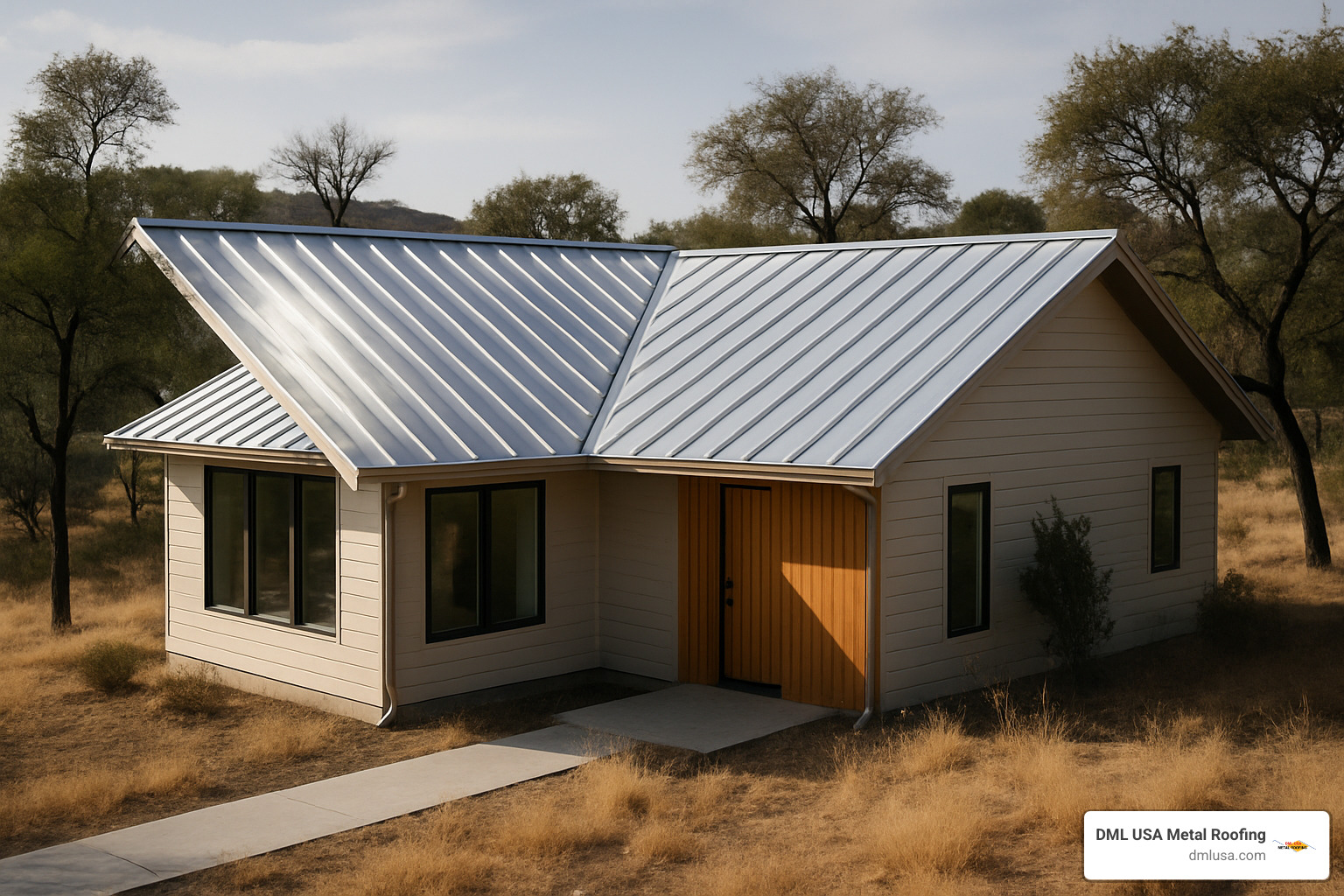
At DML USA Metal Roofing, our Class A metal roofing products qualify for energy tax credits thanks to their heat-reflective properties. This means you can enjoy improved fire protection and lower energy bills simultaneously – a winning combination for today’s homeowners.
Vulnerabilities & Maintenance Even With Class A Roofs
Even the best Class A roofing materials aren’t a complete fire-protection solution on their own. Think of your roof as your home’s first line of defense – strong, but with a few points that need extra attention. Let’s explore these vulnerable areas and how to address them.
Critical Vulnerability Points
Your Class A roof has several areas where embers might find their way in, despite the material’s excellent fire resistance.
Those roof edges and eaves where your roof meets your walls? They’re particularly vulnerable. I’ve seen countless cases where debris-filled gutters ignite at these roof-wall intersections during wildfires, creating a perfect entry point for flames.
Valleys – those areas where two roof planes meet – naturally collect leaves, pine needles, and other combustible debris. Without proper construction using either metal flashing (at least 0.019-inch galvanized sheet metal) or closed-valley construction with interwoven Class A materials, these areas become surprisingly vulnerable.
Every roof penetration creates a potential weak point in your fire defense system. Vents, skylights, chimneys – they all interrupt the continuous protection of your roofing material. Research consistently shows that homes with complex roof designs featuring multiple penetrations face significantly higher risks during wildfire events.
And don’t overlook your gutters. That collection of dry leaves and pine needles sitting in your gutters is essentially kindling placed at the vulnerable edge of your roof.
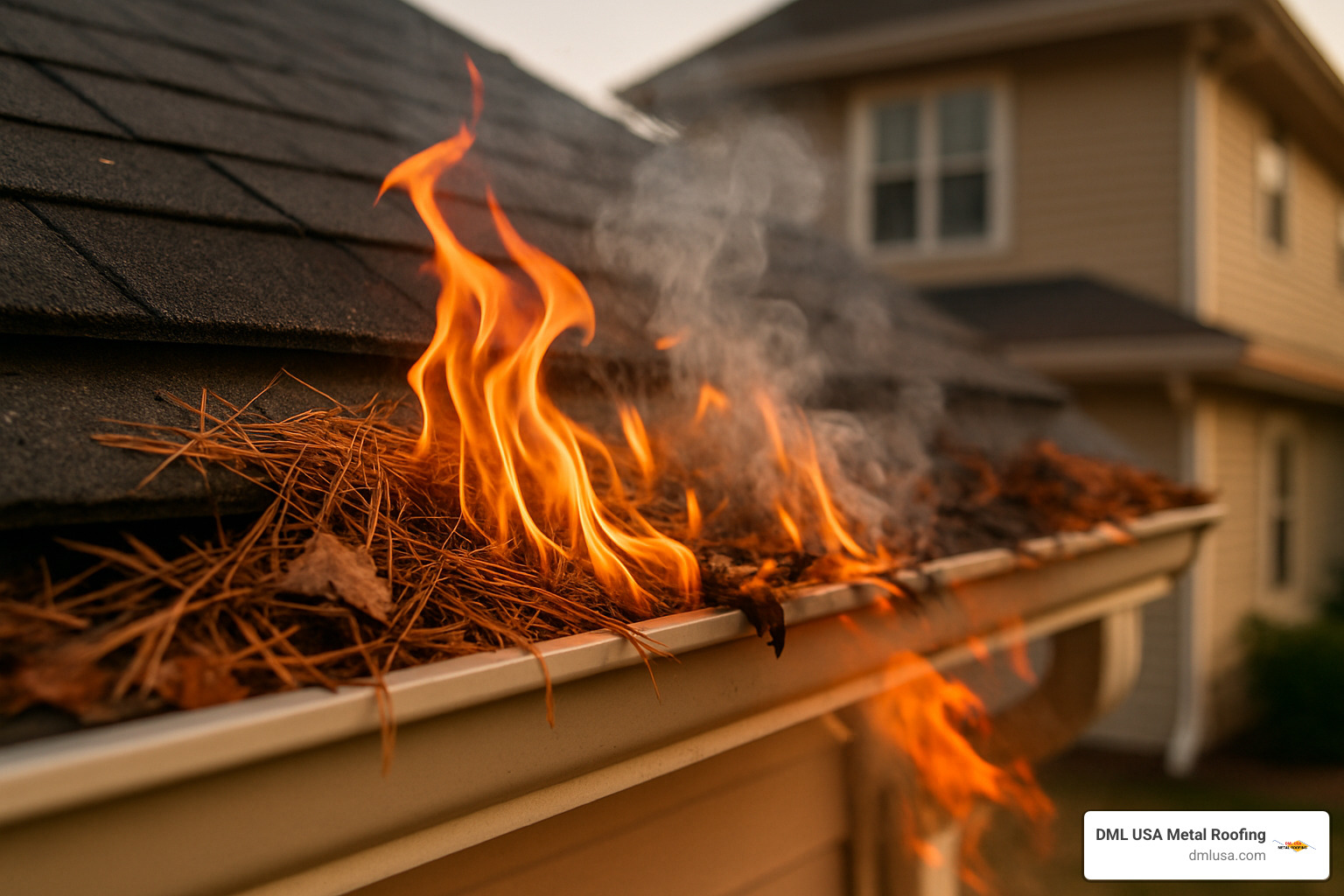
Essential Maintenance Practices
Your Class A roofing materials will provide the best protection when paired with regular maintenance. Think of it as teamwork between you and your roof.
Regular debris removal is perhaps the most important maintenance task. Clear those roof surfaces, valleys, and gutters of leaves, needles, and other combustible materials. This is particularly important during fall and right before fire season in vulnerable areas. Those piles of dry debris are just waiting for a stray ember.
Don’t neglect vegetation management around your home. Those overhanging tree branches might look lovely, but they’re dropping debris directly onto your roof and providing a pathway for fire to reach your home. Trim them back, remove dead vegetation near your house, and maintain proper defensible space.
Set a calendar reminder for regular inspection and repair. Look for damaged or missing roofing materials that might compromise your Class A protection. If you have a tile roof, check that the bird-stopping (those materials that block gaps at the edges) remains intact. These small gaps can allow embers to slip under the tiles despite their non-combustible nature.
As one homeowner told me after a close call with a wildfire: “I never realized how important those routine roof cleanings were until I saw my neighbor’s house catch fire from embers in their gutters. Now I’m religious about keeping mine clean.”
Pre-Evacuation Tactics
If you live in a wildfire-prone area, having a pre-evacuation routine for your roof can provide extra protection.
Before evacuating, close any operable skylights and quickly remove any branches that have fallen on your roof. Some fire safety experts even recommend plugging downspouts and filling gutters with water to reduce ember ignition risk – though this is only for immediate pre-evacuation, not regular practice.
Despite the fire risk they present, gutters should not be removed because they play a critical role in moisture management for your home. Instead, invest in quality gutter covers or commit to regular cleaning – your roof will thank you during both rainy and fire seasons.
Defensible Space Integration
Your Class A roof works best as part of a comprehensive approach to fire safety. Think of defensible space as concentric rings of protection around your home:
Zone 1 (0-5 feet from your home) should contain only non-combustible materials – no wood mulch, flammable plants, or stored firewood.
Zone 2 (5-30 feet out) should feature limited vegetation with well-spaced plants and no “ladder fuels” that allow fire to climb from the ground to your roof.
Zone 3 (30-100 feet out) needs reduced fuel through strategic thinning and pruning.
As one wildfire preparedness expert puts it: “Your roof protects your house from the elements, yet its large surface area makes it vulnerable to embers during a fire.” This vulnerability is precisely why even the best Class A roofing materials need to be part of a broader fire safety strategy.
At DML USA Metal Roofing, we understand that our Class A metal roofing products are just one piece of your home’s fire protection puzzle – albeit an important one. The right maintenance and surrounding defensible space will maximize the protection our fire-resistant roofing materials provide.
Building Codes, Regulations & How to Verify Your Roof
Understanding the rules around Class A roofing materials might seem overwhelming, but it’s essential knowledge for homeowners, especially those in fire-prone areas. Let’s walk through what you need to know about codes, regulations, and verifying your roof’s fire rating.
Key Building Codes and Regulations
If you’re building or re-roofing, you’ll encounter several important building codes that govern fire ratings:
The International Building Code (IBC) and International Residential Code (IRC) serve as the foundation for most local building requirements. These codes establish the baseline standards for roof coverings based on your building type and location. Most cities and counties adopt these codes but may add their own local amendments.
For those living where development meets wilderness—what experts call the Wildland-Urban Interface (WUI)—specialized codes often apply. This isn’t a small concern; research shows WUI areas are growing by about 2 million acres each year, with over 60,000 communities now facing wildfire risks. If you live in one of these areas, your roof requirements will likely be stricter.
California Building Code Chapter 7A has become the gold standard for wildfire building regulations. If you’re in California, this pioneering code establishes mandatory Class A roofing requirements in designated fire hazard zones. Many other states now model their regulations after California’s approach.
Don’t forget to check local amendments and requirements. As one building official told me, “Always consult your local building or fire department for required roof fire ratings in your area. Local rules often go beyond the model codes.”
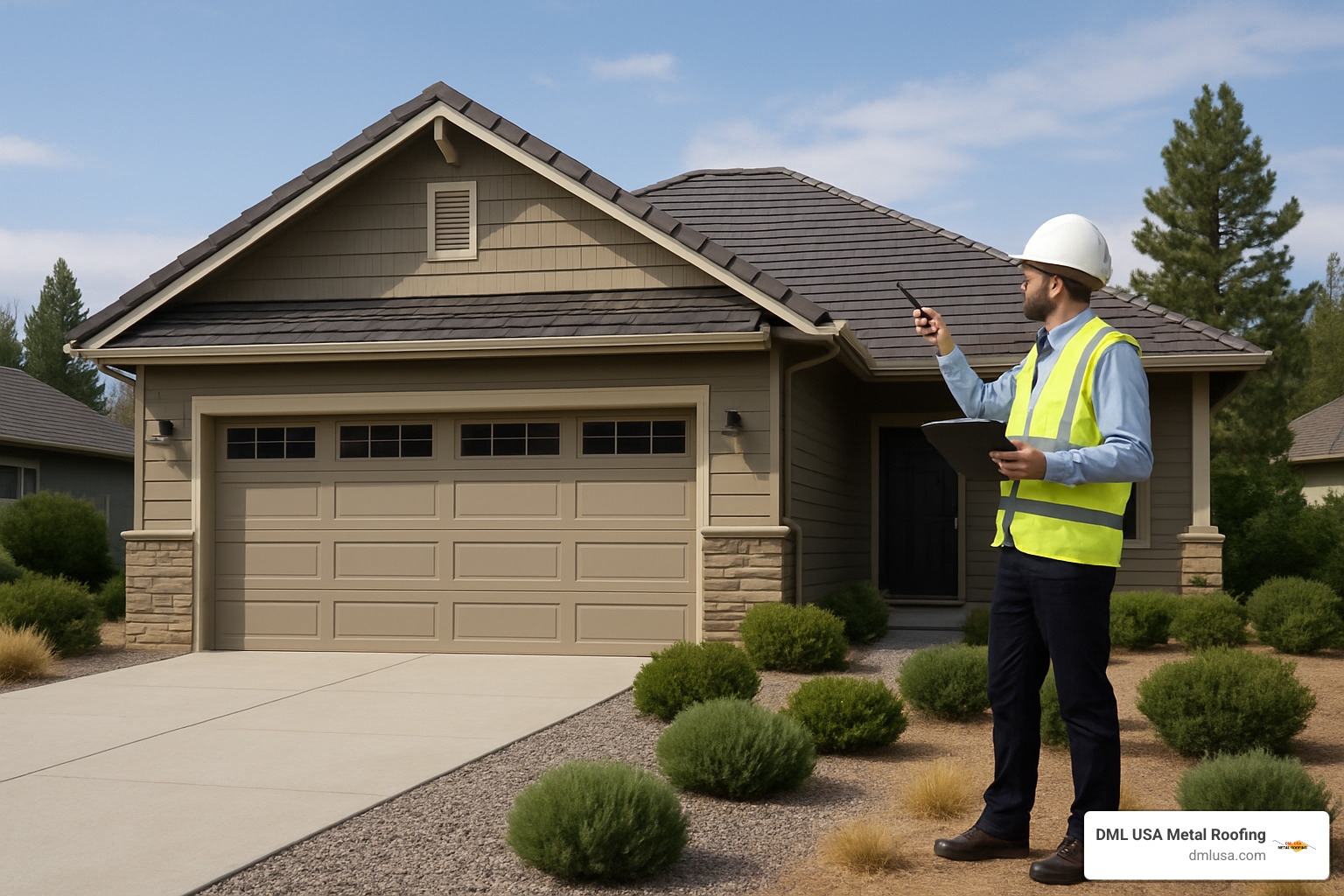
How to Verify Your Roof’s Fire Rating
Not sure if your current roof meets Class A standards? Here are practical ways to find out:
Start with a documentation review. Check your original building permits and inspection records—these typically note the roof’s fire rating. Look for product packaging in your garage or attic, or any labels that might have been left in the attic space. If you’re still uncertain, try contacting your original roofing installer, who should have records of the materials used.
When documentation isn’t available, consider a professional inspection. A qualified roofing contractor can usually identify your roofing material and its likely fire rating with a visual inspection. Your local building department might also provide guidance, and some fire departments offer home safety inspections that include roof assessments.
In rare situations where documentation isn’t available and knowing the exact rating is critical—perhaps for insurance requirements—you can arrange for laboratory testing. Small samples of your roofing can be submitted to certified labs to determine the fire classification, though this is rarely necessary for most homeowners.
The WUI Product Handbook
For those in wildfire-prone regions, the Wildland-Urban Interface (WUI) Product Handbook is an invaluable resource. Maintained by the California Office of the State Fire Marshal, this comprehensive guide lists approved materials for WUI areas, provides verification methods for fire ratings, and offers guidance on proper installation techniques.
I’ve found this handbook particularly useful when talking with contractors or building officials, as it provides a common reference point for fire-resistant building materials beyond just roofing.
Understanding Product Labeling
Manufacturers of Class A roofing materials typically include fire rating information on their packaging and sometimes on the products themselves. When examining these labels, look for:
The UL Class A, B, or C designation clearly marked on packaging. References to ASTM E108 or UL 790 testing standards indicate proper testing has been performed. Check whether the product has a “stand-alone” rating or requires a specific “by-assembly” installation to achieve its fire rating.
Pay special attention to underlayment requirements for assembly ratings. As one roofing specialist emphasized to me, “When using by-assembly systems, include the tested underlayment exactly as specified. Any deviation could compromise the fire rating.”
The Role of the Authority Having Jurisdiction (AHJ)
Your local building department—formally known as the Authority Having Jurisdiction (AHJ)—has the final say on whether your roofing material meets code requirements. They’re not just bureaucratic problems; they’re there to ensure your home is safe.
The AHJ may require documentation of testing and certification before approving your roofing project. They’ll often conduct inspections during installation and issue final approval based on compliance with local codes. Building a cooperative relationship with your local building department can make the entire process smoother and ensure your roof meets all applicable fire safety requirements.
At DML USA Metal Roofing, we’re familiar with these regulations and can help guide you through the process of selecting Class A roofing materials that meet both the letter of the law and the practical needs of protecting your home from fire dangers.
Frequently Asked Questions about Class A Roofing Materials
What is the lifespan difference between Class A materials?
When investing in Class A roofing materials, one of the first questions homeowners ask is “how long will it last?” The answer varies quite a bit depending on what you choose.
Metal roofing stands out as the marathon runner of the group. Steel panels typically last 40-70 years, while copper can protect your home for 70+ years, and aluminum usually serves faithfully for 50+ years. At DML USA Metal Roofing, we engineer our metal roofing systems for maximum longevity, backing them with warranties that reflect our confidence in their staying power.
Concrete and clay tiles are the heavyweight champions of durability. Concrete tiles generally last 50+ years, while clay tiles can protect homes for an impressive 75+ years. These materials might need occasional maintenance of their mortar or fastening systems, but their fundamental protection remains intact for generations.
On the more affordable end, fiberglass asphalt composition shingles offer shorter but still respectable lifespans. Basic 3-tab shingles typically last 15-25 years, architectural shingles extend that to 25-30 years, and premium architectural options can protect your home for 30-40 years. While they don’t match the longevity of metal or tile, their lower installation cost makes them a practical choice for many homeowners.
Synthetic slate and shake products bridge the gap nicely, typically lasting 30-50 years. These materials offer an excellent middle ground between standard asphalt shingles and premium materials.
As one roofing contractor with decades of experience told me, “The higher upfront cost of premium Class A roofing materials like metal or tile essentially pays for itself through their significantly longer lifespan and reduced maintenance needs.”
Can I upgrade an existing roof to Class A without full replacement?
Good news for many homeowners – you may be able to improve your roof’s fire resistance without tearing everything off and starting from scratch.
Overlay systems offer one practical approach. Metal roofing can often be installed directly over existing asphalt shingles, instantly upgrading fire protection. There are also specialized underlayment systems that can improve the fire rating of the overall roof assembly.
For wood shake roofs, fire-retardant treatments can sometimes provide a temporary solution. These chemical treatments improve fire resistance, though they do require periodic reapplication to maintain effectiveness.
During repairs, you might consider partial assembly upgrades. Adding fire-resistant underlayment when replacing sections of roofing or installing fire-resistant materials at vulnerable points like valleys and eaves can make a significant difference.
However, I should mention some important limitations to these approaches. Building codes don’t always recognize partial upgrades, insurance companies might still classify your roof based on the original material, and the effectiveness may not match a complete replacement with true Class A roofing materials.
One fire safety expert I spoke with was particularly blunt about certain situations: “Untreated wood shake roofs have no mitigation option other than full replacement.” In such cases, installing a new Class A roof is the only reliable solution.
Do Class A roofs qualify for energy tax credits?
Many Class A roofing materials pull double duty – protecting your home from fire while also helping you save on energy costs and potentially qualifying for tax incentives.
Metal roofing with ENERGY STAR-qualified coatings often qualifies for federal tax credits. These cool-roof coatings reflect solar radiation away from your home, significantly reducing heat gain and summer cooling costs. At DML USA Metal Roofing, our metal roofing systems frequently qualify for these incentives, offering both fire protection and energy efficiency.
Beyond metal, other energy-efficient Class A options include tiles with reflective coatings, synthetic materials designed with solar-reflective properties, and even some asphalt shingles featuring specialized cooling granules.
The specific credits available to you will depend on current federal, state, and local incentive programs, the specific energy properties of your chosen material, and proper documentation of those properties.
As an energy efficiency consultant recently explained to me, “The sweet spot where fire safety meets energy efficiency creates a genuine win-win for homeowners who choose reflective Class A roofing materials.”
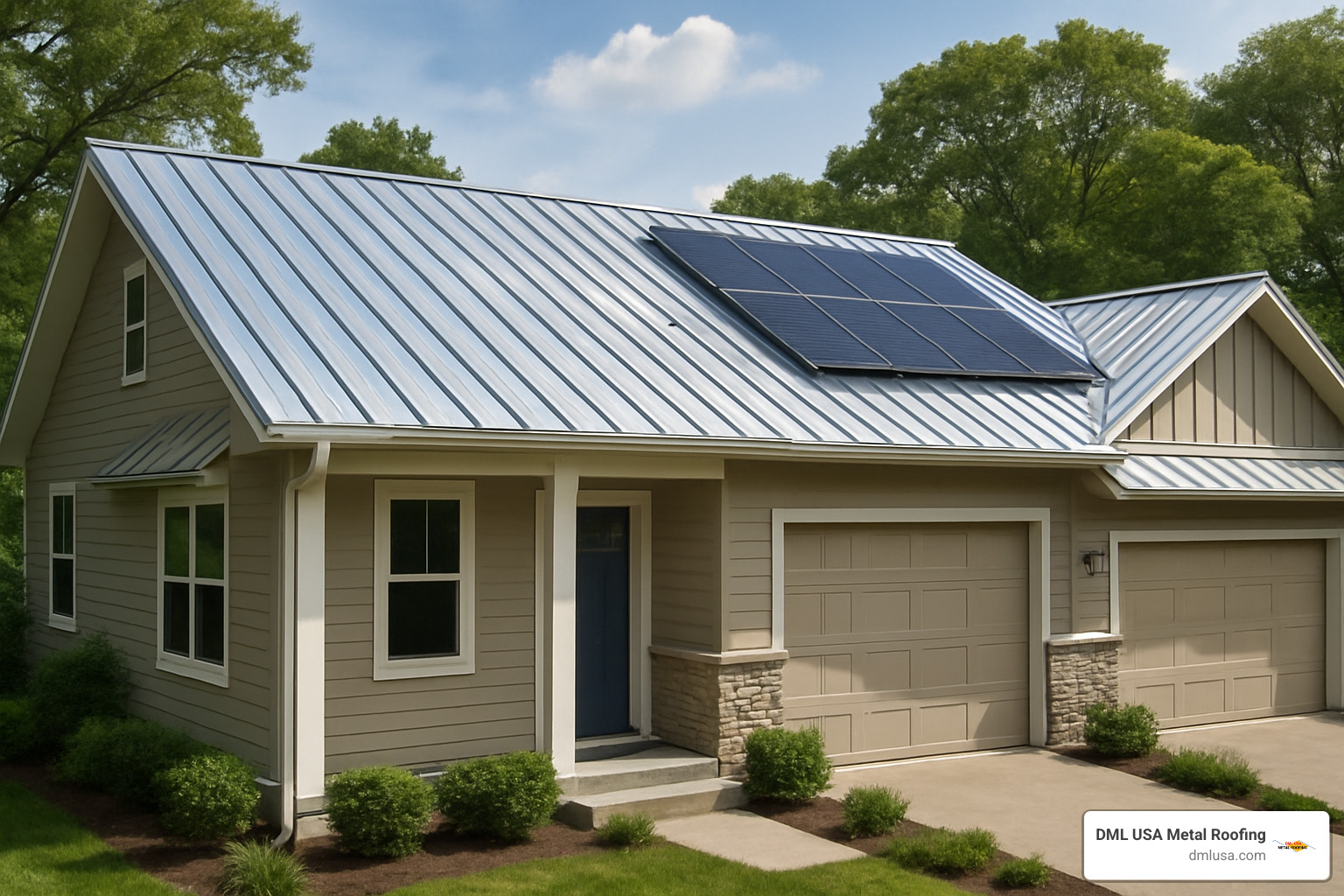
For the most current information on available tax credits, I recommend talking with a qualified tax professional or visiting the Energy Star website. The landscape of incentives changes frequently, and you’ll want the most up-to-date information when making your roofing decision.
Conclusion
Choosing the right Class A roofing materials represents one of the most important decisions you can make to protect your home from fire. These materials have proven their worth in countless wildfire events, often making the difference between a home surviving or being destroyed.
Throughout this guide, we’ve explored fire-resistant roofing in depth. We’ve seen how materials must endure punishing tests to earn their Class A status – from burning brands placed directly on the surface to wind-driven flames testing their limits. This isn’t just marketing hype; it’s science-backed protection for your most valuable asset.
We’ve examined a variety of Class A roofing materials that can shield your home – from the timeless durability of metal and tile to the practicality of fiberglass asphalt and the innovative technology behind synthetic options. Each brings its own blend of protection, aesthetics, and value to the table.
Remember the critical distinction between stand-alone and assembly-rated systems. That seemingly small detail can make a huge difference in real-world performance. Even with the best materials, those vulnerable points we discussed – valleys, edges, penetrations – need special attention during installation and maintenance.
No single roofing material is perfect for every situation. Your ideal choice depends on several factors unique to your circumstances. Local climate and fire risk vary dramatically across regions. Building codes and HOA requirements might limit your options. Budget constraints are real for most homeowners. And let’s not forget that your roof is a major design element affecting your home’s appearance and value.
What remains constant, however, is the peace of mind that comes from knowing your roof offers the highest level of fire protection available. When you see news footage of neighborhoods devastated by wildfire with a few homes left standing, the difference often comes down to thoughtful fire-resistant design choices – with roofing leading the way.
At DML USA Metal Roofing, we’re proud to manufacture high-quality, Class A metal roofing systems that combine superior fire protection with exceptional durability, energy efficiency, and aesthetic appeal. Our Illinois-made products are designed to withstand not just fire but also the challenges of wind, hail, and time itself.
Even the best roofing material is only as good as its installation and maintenance. Working with qualified professionals and maintaining your roof’s fire-resistant properties through regular care ensures that your investment continues to protect your home for decades to come.
For more information about our Class A metal roofing products and how they can protect your home, visit our products page or contact our team in Northlake or Chicago, Illinois. Your family’s safety is too important to trust to anything less than the best fire protection available.

